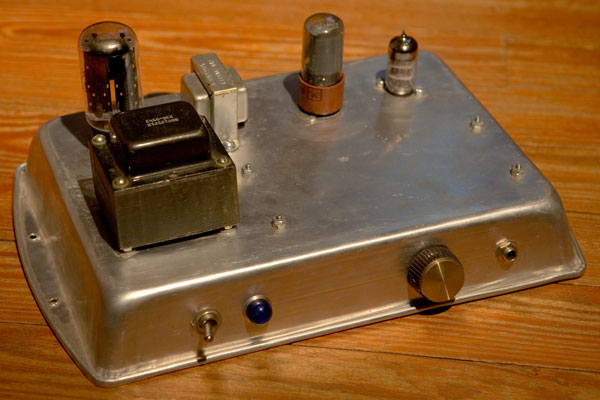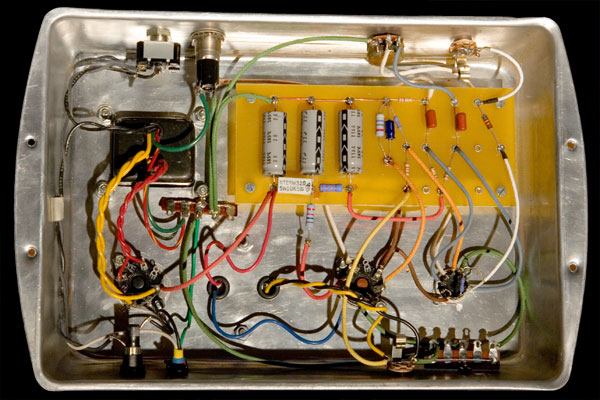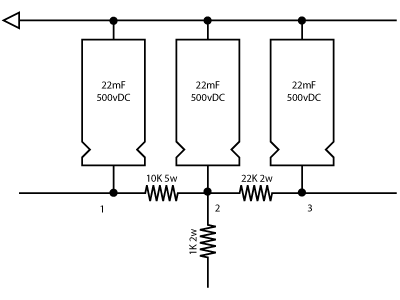Greetings,
I've begun troubleshooting a small amp I built about 10 years ago. It was loosely based on a Fender 5F1 with a 5U4GB and larger value power filter caps as exceptions to the original design.

The amp played well. I used it hard for many years as a recording amp, but recently it began osciallating at a low frequency. I gave it a general clean up and the amp now seems stable. But it seems like the power transformer has begun to vibrate which I don't recall it having done before. There is a audible hum in the speakers with the volume turned all the way up. Yesterday I let it stand in the on position for a few hours to get it hot and then I played it loud. When I really drove amp hard it would drop out momentarily. I pulled the chassis and did some voltage measurements this morning. This evening I played it a little and now see there is a very small spark near the base of the 6v6GT tube when I really dig into the guitar.

I ordered new power caps and I'll replace them and the bypass cap ASAP.
In addition to the noticable vibration, I've also noticed the power tranny gets very warm... I don't recall that happening before. It's a New Sensor NSC125P1B.
I did both vDC and vAC measurements today:

vDC with tubes at idle:
1) 422
2) 373
3) 327
Someone on another thread suggested that a shorted Cap might draw down the B+. These voltages seem to be pretty well matched.
vDC without tubes:
1) 516
2) 514
3) 512
I was curious about ripple at idle.
vAC with tubes:
1) 3
1) 0
1) 0
Is the 3 vAC at "1" a normal ripple?
I did one other thing out of curiosity. I recently watched a Gerald weber video and he demonstrated a way to discharge the power caps by connecting to pin 1 of the preamp tube and jumpering to ground. The premiss is that there is enough resistance in the circuit that you don't need a resistor in line with your jumper. He recomends 20 secs.
After I "discarged" the caps in that manner I placed a dc voltmeter across the same connections and watched the voltage climb to 8vDc. I reattached the grounding jumper and repeated the test a few times. It seemed to take 20 minutes before the vDC was below 1vDc. Is that normal?
I'm just looking to learn a few things and need experience troubleshooting. Can anyone suggest anything of note to look for after considering some of what I detailed above?
Thanks,
mike
I've begun troubleshooting a small amp I built about 10 years ago. It was loosely based on a Fender 5F1 with a 5U4GB and larger value power filter caps as exceptions to the original design.

The amp played well. I used it hard for many years as a recording amp, but recently it began osciallating at a low frequency. I gave it a general clean up and the amp now seems stable. But it seems like the power transformer has begun to vibrate which I don't recall it having done before. There is a audible hum in the speakers with the volume turned all the way up. Yesterday I let it stand in the on position for a few hours to get it hot and then I played it loud. When I really drove amp hard it would drop out momentarily. I pulled the chassis and did some voltage measurements this morning. This evening I played it a little and now see there is a very small spark near the base of the 6v6GT tube when I really dig into the guitar.

I ordered new power caps and I'll replace them and the bypass cap ASAP.
In addition to the noticable vibration, I've also noticed the power tranny gets very warm... I don't recall that happening before. It's a New Sensor NSC125P1B.
I did both vDC and vAC measurements today:

vDC with tubes at idle:
1) 422
2) 373
3) 327
Someone on another thread suggested that a shorted Cap might draw down the B+. These voltages seem to be pretty well matched.
vDC without tubes:
1) 516
2) 514
3) 512
I was curious about ripple at idle.
vAC with tubes:
1) 3
1) 0
1) 0
Is the 3 vAC at "1" a normal ripple?
I did one other thing out of curiosity. I recently watched a Gerald weber video and he demonstrated a way to discharge the power caps by connecting to pin 1 of the preamp tube and jumpering to ground. The premiss is that there is enough resistance in the circuit that you don't need a resistor in line with your jumper. He recomends 20 secs.
After I "discarged" the caps in that manner I placed a dc voltmeter across the same connections and watched the voltage climb to 8vDc. I reattached the grounding jumper and repeated the test a few times. It seemed to take 20 minutes before the vDC was below 1vDc. Is that normal?
I'm just looking to learn a few things and need experience troubleshooting. Can anyone suggest anything of note to look for after considering some of what I detailed above?
Thanks,
mike
Comment